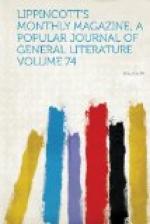If a large nerve be exposed in one of the lower animals, and a galvanic current be sent through it for half a minute or more, the temperature of the animal falls very decidedly; and if the irritation be repeated several times at intervals, the diminution of the animal heat may amount to several degrees. Galvanization of a nerve affects very powerfully the circulation, and it has been believed that this derangement was the cause of the lessened chemical movements. But the alteration of the circulation is immediate, and ceases almost at once when the current is broken, whereas the fall of temperature comes on only after several minutes, then progressively increases, and persists for many minutes—it may be hours. The two phenomena being thus differently developed, it is impossible that they should have the relation of cause and effect, and the fall of temperature must be traced to a direct influence of the nervous system upon the chemical processes of the body.
This lowering of temperature under the influence of a powerful irritation of a nerve-trunk or of its minute branches, which everywhere pervade the tissues and spread out in the skin, is common to all species of mammals. If a rabbit be merely tied down tightly upon a table, the fall is perceptible, and if it be severely wounded, the temperature diminishes very greatly. It has long been known that severe burns are followed by a very great depression of the animal heat. Redard, a French physician, made during the late siege of Paris a most interesting series of observations upon the influence of severe gunshot wounds. He found that, entirely independent of any haemorrhage which might have occurred, the temperature fell enormously, and in direct proportion to the gravity of the wound; so that by the aid of the thermometer he was able to predict whether a fatal issue would or would not occur in the course of a few hours.
We have found that both in man and the lower animals the nervous system is able to check the chemical movements of the body, but before we can decide how it does so facts not yet noticed must be looked at.
If the spinal cord of an animal be cut just below the origin of the nerves of respiration, an immediate fall of temperature occurs, and, if the animal be left in a cool room, persists until death ensues. If, however, the victim be put in a warm place, after a time the temperature begins to rise, and finally a most intense fever is developed. Parallel phenomena follow division of the spinal cord in man. Indeed, Sir Benjamin Brodie was first led to experiment upon animals by observing in 1837 an excessive fever follow in a patient a wound of the spinal cord.




